
How to Plan & Execute Your Next Project Kickoff Presentation


Some of the most successful projects out there didn’t kick off with fireworks.
Before the big launch, sprint planning or the dashboards lit up, there was a kickoff meeting.
Kickoff presentations set your team up for success. They get everyone moving in the same direction from day one and lay the foundation for accountability, communication and execution.
This might not be the only secret to project success but one thing’s clear: projects with clear direction and early buy-in move faster, stay on track and deliver better outcomes.
Not sure how to create one for your next project? You’re in the right place.
In this guide, we’ll walk you through exactly how to plan, build and deliver a project kickoff presentation that gives your team a clear roadmap, boosts momentum and earns stakeholder confidence from the start.
The project kickoff presentation is the first meeting that officially marks the start of a project. It’s typically led by the project manager and delivered to everyone involved in the project, including the project team, sponsors, clients and other stakeholders.
During the live or virtual kickoff meeting, the team walks through the project’s objectives, scope, timeline, roles and communication plan using slide decks. These slides help visualize expectations, align everyone on goals and set a strong foundation for collaboration moving forward.
Starting your project without a kickoff meeting is like setting off on a road trip without a map or a clear destination. Sure, you’ll get somewhere eventually, but probably not where (or when) you intended.
As David Hamburger, a management consultant in the United States, puts it:
“Every day wasted in getting organized at the beginning of a project is a day that the project manager will wish was available at its conclusion. An effective ‘kick-off’, both internally and in the initial client meeting, is needed to get the project started off on the right foot, heading in the right direction, as quickly as possible.”
A kickoff meeting lays the foundation for success. It brings everyone together to align on goals, scope, roles and timelines before the real work begins.
Without that shared understanding, teams can easily veer off course, waste time on frivolities or duplicate efforts.
But there are many more reasons to hold one. A project kick-off meeting:
There’s no universally accepted formula for a project kickoff presentation.
The reason is that every project has its own context influenced by the industry, company culture, strategic priorities and the people involved.
But after reviewing strong examples and drawing on real-world experience, a few key elements show up again and again in successful kickoffs.
Remember, these elements aren’t cast in stone, but they are a good starting point to help you cover all the right bases.
Made with Visme Infographic Maker
1. Project Overview: Start with a high-level summary of what the project is about, why it’s important and who it serves. What’s the business case or strategic driver?
2. Objectives & Success Criteria: Define what success looks like. Outline the intended outcomes and, if possible, tie them to specific KPIs or OKRs. Also, highlight any key constraints—timeline, budget, scope—that the team needs to keep front of mind from day one.
3. Scope & Deliverables: Clarify what’s included in the project and, just as importantly, what’s not. Outline major deliverables, phases and any notable exclusions. Setting these boundaries early helps manage expectations and prevent scope creep.
4. Timeline & Milestones: Share a high-level view of the project schedule. Identify major phases, key decision points and any dependencies that could affect delivery. This helps everyone understand the pacing and critical checkpoints.
5. Governance & Roles: Lay out who’s responsible for what. Introduce the core team, sponsors and key stakeholders. If you're using a RACI or similar model, explain how decisions will be made and how issues will be escalated.
6. Risks & Assumptions: Highlight any known risks or uncertainties early. Discuss the key assumptions baked into the plan, such as resource availability, dependencies or external factors.
7. Communication Plan: Explain how the team will stay aligned. What’s the meeting cadence? What tools will be used for updates and collaboration (e.g., Slack, email, dashboards)?
8. Operating Model: Describe how the team will work together. Who’s leading which workstreams? How will progress be tracked and shared? Think of this as the playbook for how day-to-day execution will actually happen.
9. Next Steps & Immediate Priorities: End your presentation with precise next steps. What needs to happen right after this meeting? Are there decisions or actions required to keep things moving?
Kickoff meetings aren’t one-size-fits-all. The way you run your kickoff should reflect the kind of project you're launching and the people involved.
In this section, we’ll walk through different types of project kickoff meetings, what sets them apart, when you should use them and what materials you’ll need to make them effective.
Made with Visme Presentation Maker
If you’re starting an internal project, you’ll need to rally your core team. These are people responsible for planning, executing and delivering the project day in and day out.
But that doesn’t mean you shouldn't prepare a polished deck or formal presentation. In fact, your slide deck should be thoughtfully structured so everyone walks away with a shared understanding of the work ahead.
Spend time walking the team through the project details, identify any roadblocks early on and build momentum before the execution phase begins.
It’s also important to give everyone space to ask questions, voice concerns or leave feedback. Someone may surface a critical conflict in timelines or flag a potential roadblock you hadn’t considered.
Internal kickoffs are also an opportunity to establish the tone and working culture of the project.
Will this be a fast-moving, all-hands sprint or a more methodical, phase-based rollout? Are decisions centralized or collaborative? Are deliverables reviewed weekly or biweekly?
If your project has C-suite visibility or requires executive-level support, a high-level kickoff meeting is necessary to engage sponsors and secure their buy-in.
These stakeholders don’t need the granular details on tasks or day-to-day milestones. So you want to focus on the big picture:
It’s also important to clarify what support you’ll need from leadership throughout the project lifecycle. Will you need them to remove blockers? Make budget decisions? Serve as champions to encourage adoption across departments?
This type of kickoff meeting helps you align leadership on strategic outcomes and reinforces executive trust in your project team. Keep the content relevant and impactful.
Highlight business value, expected ROI and the governance model that will guide decision-making.
Required materials:
When you’re leading a project for a client—whether it’s a creative campaign, a product development or a strategic initiative—a formal kickoff meeting is a critical first step. It’s your moment to establish trust, set expectations and create a shared understanding of the work ahead.
Begin by introducing each person on both sides of the table and explaining their roles and responsibilities. From there, outline the goals of the project in a way that ties them back to the client’s broader business objectives.
You’ll also want to align on the mode and frequency of communication (e.g., weekly status calls, biweekly check-ins or shared dashboards), review the approval process for deliverables and clarify how issues will be flagged and resolved.
If you're working with a new client who hasn’t been through a formal project process with your team before, take the time to explain how each project phase will unfold and what’s expected from them at each step, especially during feedback and review cycles.
Before wrapping up, walk the client through what success looks like, how you’ll track it and when they can expect major milestones.
If timelines are subject to change based on client input or review delays, this is the time to proactively discuss that too. The goal is to eliminate gray areas and walk away with a solid agreement on scope, roles and next steps.
If you’re launching an Agile project, especially one that involves multiple sprints or cross-functional team members, you’ll want to start with a dedicated kickoff meeting. It helps to establish alignment around scope, roles, sprint goals and standard operating procedures.
Most Agile teams don’t hold kickoff meetings before every sprint and they shouldn’t. Doing so would bog down the rhythm of iteration and slow down delivery.
However, a well-planned project kickoff at the start of a new initiative (or even once a year for long-running teams) keeps everyone on the same page while also creating a solid baseline for future process improvements.
Use this meeting to:
It’s also the right time to establish your definition of “done” and discuss any tools or boards you’ll be using to manage work collaboratively.
This definition should cover both technical completeness (e.g., tested, peer-reviewed, merged) and functional readiness (e.g., meets acceptance criteria, stakeholder approval, ready for release).

Clients often come in with assumptions, so you need to set things straight from the start. Use this project presentation to clarify the scope, deliverables, timelines and constraints before the project gains momentum.
This template has pre-designed slides for laying out the project overview, campaign objectives, KPI and success metrics, scope of work, key deliverables, team structure, timeline and milestones and other important details.
Feel free to customize this template to fit your project needs. You can edit content, change images, apply custom colors, upload your own fonts, logo and other design elements.
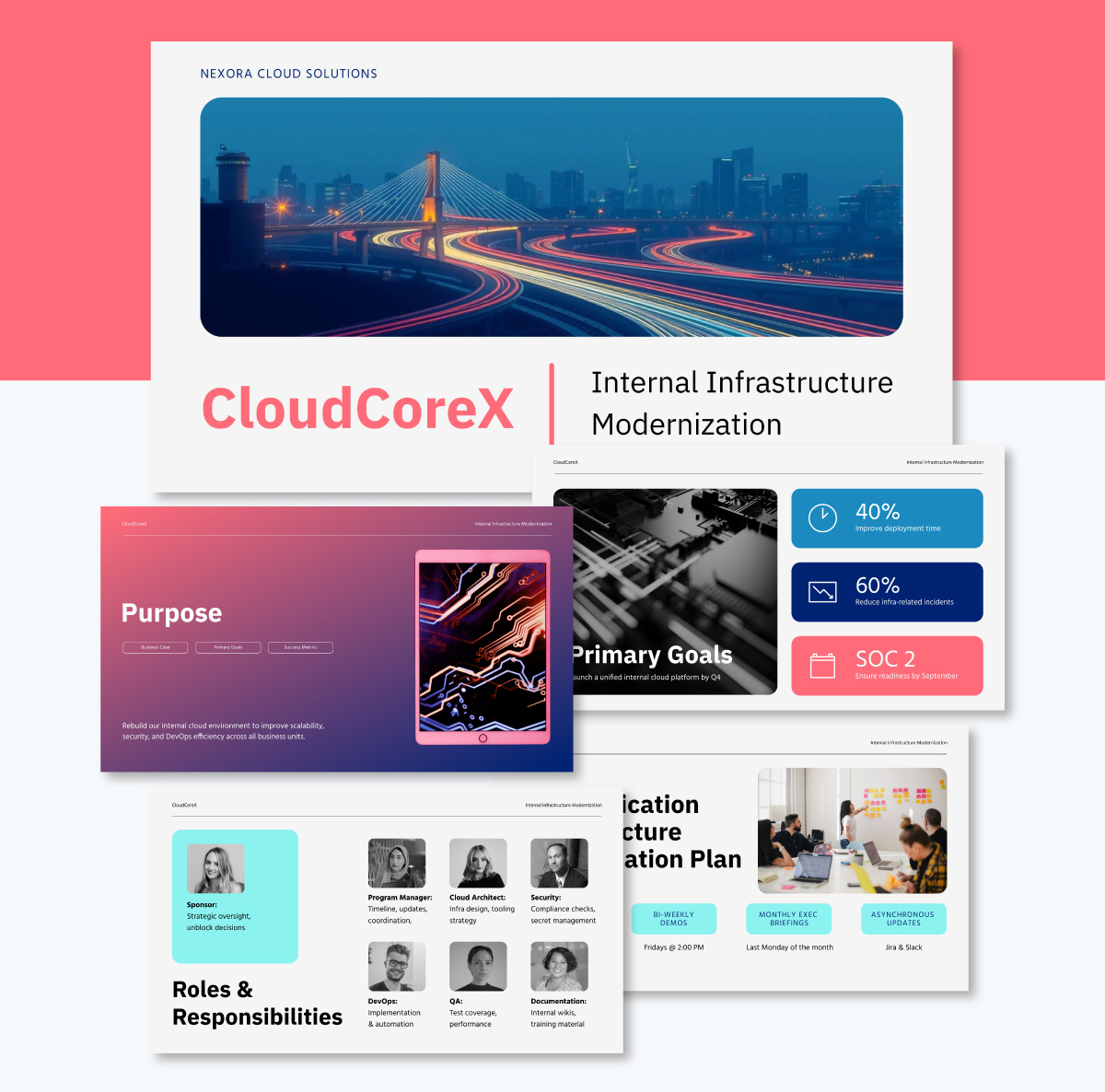
When it comes to internal project kickoffs, you're speaking to colleagues who probably have some shared context about the project value.
This presentation template is your go-to resource for communicating execution plans, bringing your team together, clarifying individual responsibilities and ironing out internal logistics.
It comes with vibrant slides that highlight the project's purpose and business case, goals, success metrics, scope of work and deliverables.
The colorful horizontal timeline makes tracking progress a breeze while a dynamic picture collage visualizes the team, clearly showing who's in charge of what. Plus, logos of the tech stack and tools are listed along with the risk and mitigation strategies, communication plan, governance and change management process.

Working on a project that involves multiple organizations or teams? Both sides bring expertise, expectations and possibly different working cultures. This kickoff presentation meeting will not only harmonize these differences but also set the tone for seamless collaboration.
During the meeting, clarify how joint decisions will be made, who leads what and how conflicts will be resolved. Unlike other kickoff presentations, this one shares a project overview, roles and responsibilities of each partner, budget overview and success metrics.
To provide more context, you can dive deeper into the working agreement that covers the details of how often you’ll meet, how feedback will be shared and how you'll keep things documented.
Visme’s AI Writer makes it easy for you to generate content ideas, drafts, outlines and overviews or even proofread existing project documentations.

In this type of work environment, timing is everything. This colorful project kickoff presentation template gives you an opportunity to visualize the schedule and discuss key milestones so nothing gets held up or done out of sequence.
It shares the project timeline in a flowchart format, while the milestones are arranged in a horizontal format along with the task name, month and date.
Another big part of the kickoff is the site conditions and safety plans. These slides help you reinforce site safety protocols, training requirements and emergency procedures so every team starts with a shared commitment to a safe work environment.
Keep your slides engaging with animations and interactive elements and rather than clutter your slides with text, you can add hover effects or link to a larger document.
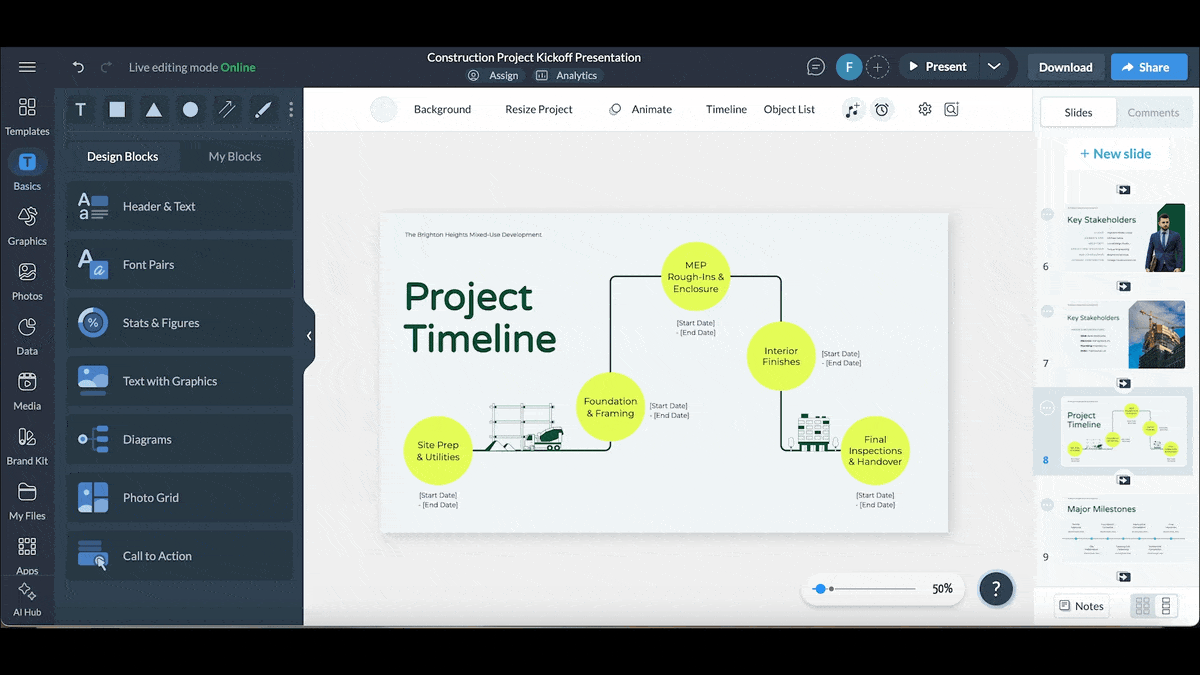

The Scrum workflow splits large projects into working chunks so teams can work on quickly and iteratively during each sprint (usually 2-4 weeks).
This slide deck design also captures the sprint cadence—when the first sprint will start, how long each sprint will last, how often you'll check progress and make adjustments as needed.
You'll find all the key Scrum events covered too, like daily stand-ups, sprint reviews, retrospectives and backlog refinement.
From a design perspective, this slide deck checks all the right boxes with eye-catching blue and gray themes.
And if you want to keep everything aligned with your brand, Visme’s Brand Wizard has got you covered!
Once you type in your website, the tool will pull in your brand assets (color, fonts and logo) and save them to your Brand Area so you can easily apply them to future projects.
R&D projects often begin with more questions than answers. The path forward isn’t always clear, so kickoff meetings for research and development are less about rigid planning and more about experimenting and discovering what works.
Use this project kickoff presentation template to lay the groundwork for collaboration and learning, whether you're developing a prototype, testing a hypothesis or pursuing a breakthrough.
It helps your team establish a shared vision, align on research goals, explore unknowns and organize the phases of experimentation.
I love how this template blends fresh lemon tones with sleek gray and crisp white accents to create a modern, professional look.
Plus, you'll find dedicated sections for project overview, research objectives, scope of work, timelines, budget and resources. Project team and roles, key stakeholders, risk and mitigation strategies, success metrics, long-term vision and next steps are all captured in separate slides.
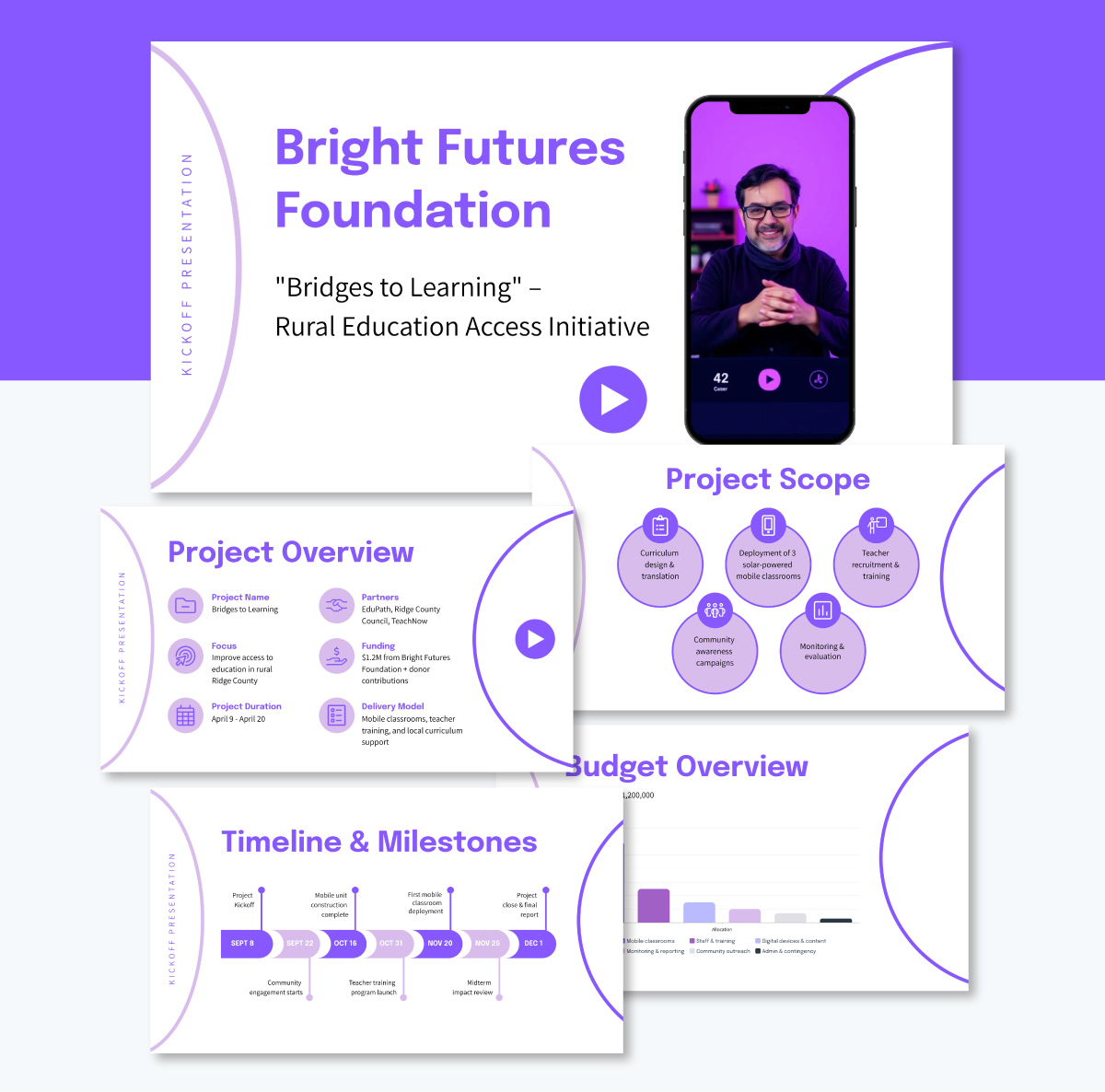
Nonprofit kickoffs carry a deeper emotional and social dimension. Staff, volunteers, funders, partner organizations and other stakeholders are aligned around a shared purpose, not just deliverables.
This nonprofit project kickoff presentation example has everything you need to energize people around a cause, clarify the path forward and turn vision into action.
You’ll find dedicated slides that cover all the essentials: project overview, mission, scope and objectives. Plus, elegant horizontal timelines and milestones keep everyone on track, alongside modern success metrics that speak to today’s audience.
The budget overview is presented with engaging charts and graphs that make it easy to digest. Throughout the slides, a beautiful range of purple hues adds a polished touch to the overall experience.
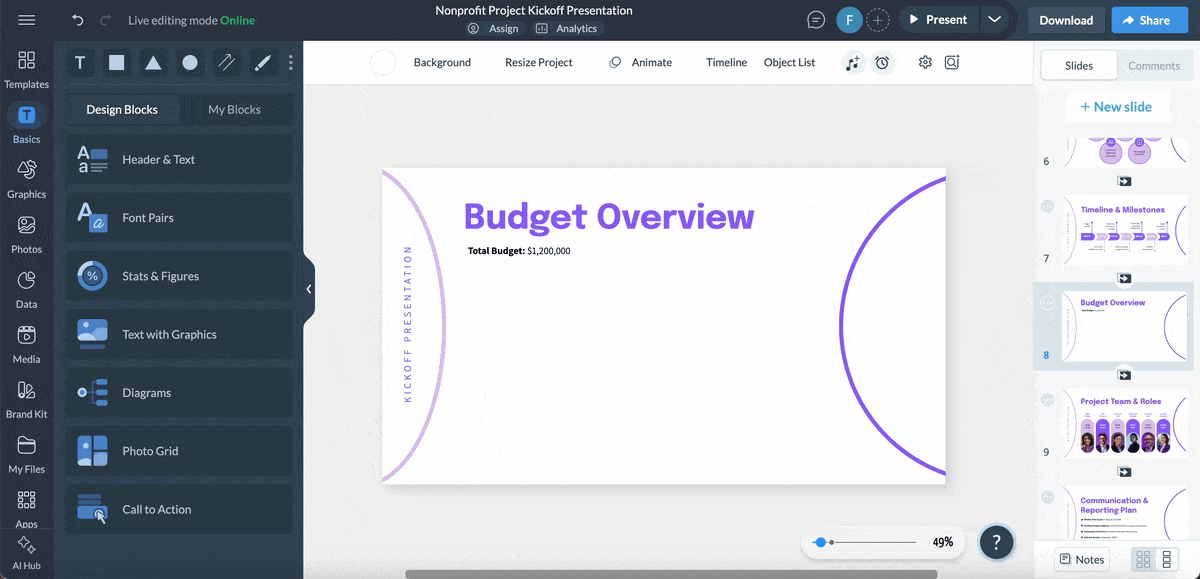
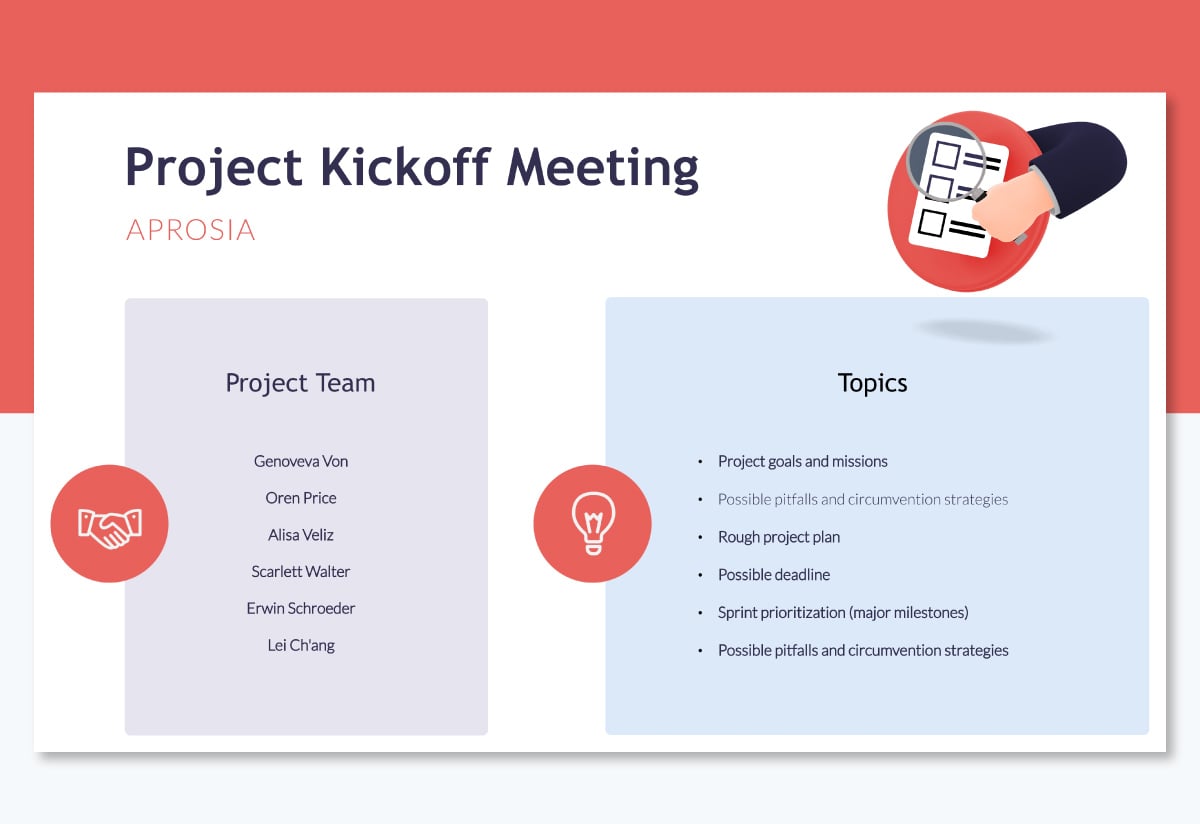
This kickoff meeting agenda template is built to help your team start strong with structure, focus and room for collaboration.
Designed using Visme’s whiteboard tool, the layout is interactive. Participants can draw live annotations during the meeting, leave comments or feedback directly on the board and collaborate visually to refine ideas or flag concerns in the moment.
On the left, you’ll find a simple text block listing the core project team, so everyone knows who’s involved and how they fit in. To the right, the project kickoff agenda walks through the key topics that shape a successful project launch.
Feel free to expand the canvas or add additional pages as needed, so there’s never a shortage of space for planning, brainstorming or evolving conversations.
If you’re the project manager (or program lead), the spotlight’s on you to lead that first kickoff meeting and get stakeholders rowing in the same direction from day one.
You need to lead the room confidently—even if it includes executives, cross-functional leads or clients you’re meeting for the first time. You also need a solid structure and practical techniques to guide the conversation and keep everyone focused.
Below, I’ll walk you through exactly how to present a successful project kickoff—before, during and after the meeting.
Made with Visme
Before you even think about putting slides together, take a step back and ask the big questions:
It sounds simple, but skipping this step can prove costly. According to the PMI, 37% of projects fail due to a lack of clearly defined and achievable milestones and objectives to measure progress.
That’s why your first job is to define the project’s purpose in clear, practical terms. This becomes your team’s north star—something to rally around and refer back to when decisions get tough.
Once you’ve nailed the “why,” get specific with measurable goals. Are you trying to boost customer satisfaction by 20%? Cut cycle times by 30%? Go live date before the end of Q3?
Use the SMART framework (Specific, Measurable, Achievable, Relevant and Time-bound) to set your goals. If you’re new to goal setting, we’ve covered this in more detail in this post.
It’s also helpful to connect the dots between this project and broader business priorities. Executives and team members are more likely to stay engaged when they understand the strategic importance of any project.
When presenting your objective, consider including a visual showing alignment with company-wide OKRs or strategic priorities.
Pro tip: Don’t wait until the kickoff to get buy-in. Bring decision-makers and team leads into the loop early. Share draft objectives, gather their input and listen for red flags. This sharpens your plan and minimizes surprise objections during the meeting itself.
A well-structured agenda is your best ally for running a smooth, productive kickoff.
In fact, 67% of professionals say a clear agenda is what makes a meeting productive. That’s a proven best practice.
It gives the session a clear structure, helps keep participants on track and ensures that nothing important slips through the cracks. The most common format is to start with a warm welcome, followed by a quick recap of how the project came to be and what it aims to accomplish.
From there, list out the critical elements: project scope, timeline, milestones, risks, team roles, communication protocols and next steps. Make each item action-oriented and time-boxed.
We've shared a meeting agenda template above that you can customize. But there's more where that came from. Check out our extensive library of customizable meeting agenda templates to find one that fits your project and style.
Send the agenda out early, ideally 2–3 days before the meeting. This gives everyone time to prep questions, review any background materials and come prepared to contribute. You can also invite stakeholders to submit concerns or topics they’d like to cover ahead of time so you’re not reactive in the room.
Pro Tip: If your kickoff is longer than 45 minutes, build in a couple of pauses for questions or discussion. Otherwise, you risk losing engagement halfway through.
Once you’ve finalized the agenda, turn your attention to the materials you’ll present and share. These assets will shape your audience’s impression of you so you have to make it top-notch.
Start by creating a compelling deck that walks through the agenda. Include high-level timelines, milestone charts, team org charts, RACI matrices (responsible, accountable, consulted, informed) and risk registers as needed.
Keep your visuals clean and focused. And resist the urge to overload your slides with text or granular data.
As project manager and content creator, @Lolathemanager puts it in her popular video about kickoff meetings:
“I like to break up my slides with graphics for the simple reason that people are in meetings all day. The goal is to make the meeting stand out. I’m not just going to read a wall of text to them; they can read. If I’ve done my job right, I should be able to walk through the project with a brief, confident summary.”
To make slide deck design easier, use one of the professionally designed kickoff deck templates shared earlier in this article. Or browse through our massive library of presentation templates to select a slide design layout that fits your project’s needs and industry context.
Invite your team into your workspace to collaborate on the deck design and review process. Assign permissions to them to either view, edit or comment on your slide and other projects. You can also use the workflow feature to assign documents to different members of the team to work on, set deadlines and track their progress towards completion.
In addition to the deck, share and download any key documentation ahead of time—this might include:
If you’re using a project management tool like Asana, Jira, Trello or Monday.com, be sure it’s already set up with the basics: tasks, deadlines, owners and a project summary. Include the project link in your invite or agenda email so attendees know where to go next.
If this is the first time the full project team is coming together, there’s a good chance not everyone knows each other. Start the meeting with quick introductions to break the ice and build a sense of connection.
Go around the (virtual or physical) room and have each person share their name, role and what they’ll be contributing to the project.
Before diving into logistics, zoom out and articulate the vision behind the project. Why are you doing this? Why does it matter? What was the original challenge or opportunity? What pain points triggered this initiative? What’s at stake if you succeed—or if you don’t?
From there, walk your audience through the project’s core objectives and success metrics.
Revisit the SMART goals you defined earlier. Explain how these goals were shaped through collaboration, who contributed input and how they connect to broader company priorities. This reinforces shared ownership and motivates the team with a clear sense of purpose.
Keep this section concise but meaningful. Consider adding visuals like:
If possible, invite your executive sponsor or department lead to say a few words. Their endorsement adds credibility and shows that leadership is invested in the project’s success.
During your kickoff presentation, draw clean lines around who’s doing what. Start by introducing the core project team. Highlight leads for each major area and then walk through functional teams, cross-departmental collaborators, key stakeholders and sponsors.
For smaller projects, you can create a simple org chart that visualizes hierarchy and lines of communication.
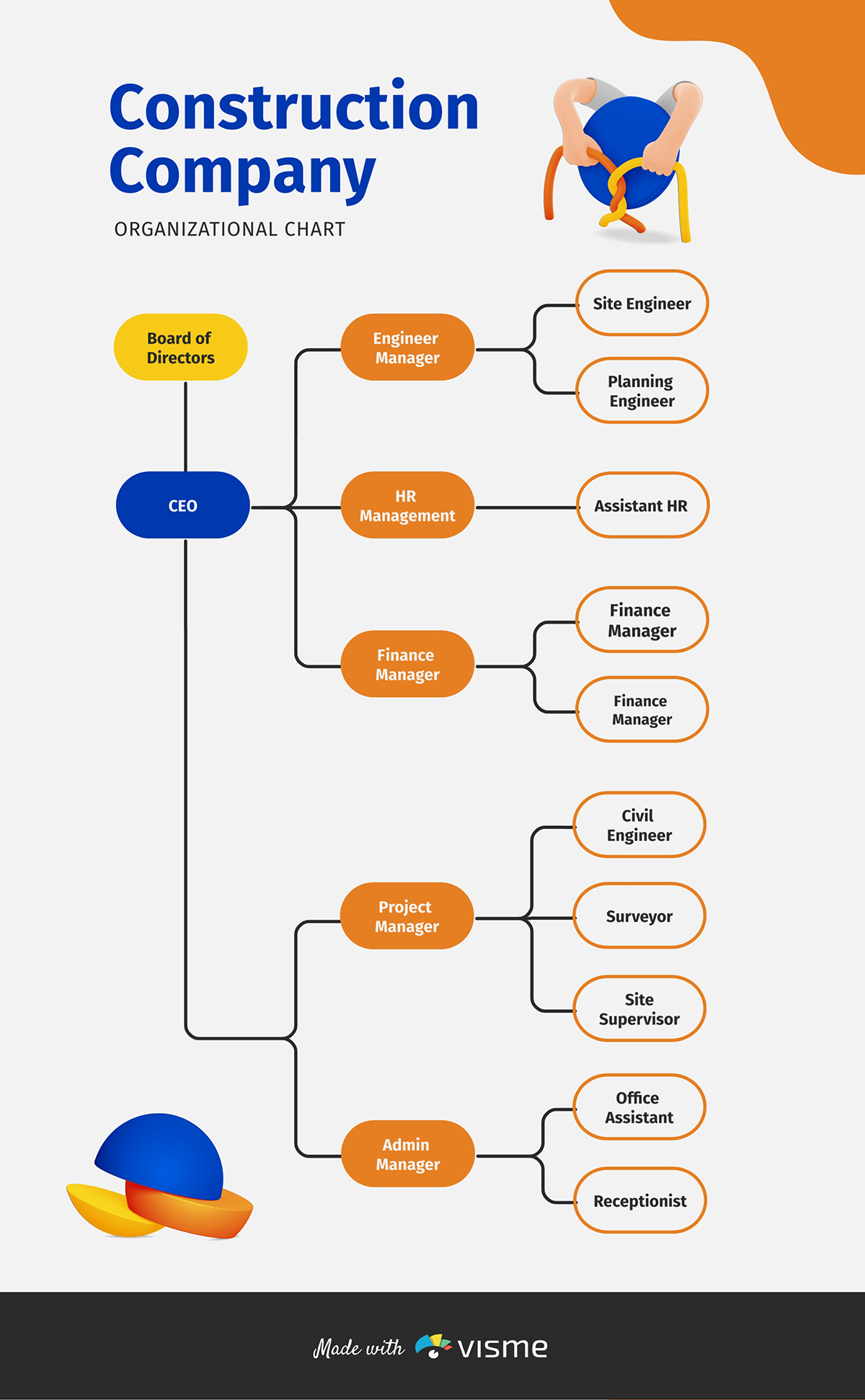
For larger or more complex projects, bring in a RACI matrix to make responsibilities crystal clear.
Visually mapping out who’s Responsible, Accountable, Consulted and Informed for key tasks removes ambiguity and gives team members a go-to reference for approvals, decisions and updates. A slide with pictures, names and roles also works well here.

Encourage questions during this part of the meeting. This is your chance to address any role overlap, missing responsibilities or unclear expectations before they turn into blockers later.
And don’t forget to walk through escalation paths. What should team members do if something goes off track? When should an issue be raised versus handled independently? Having these answers upfront does two things:
The result? Fewer surprises, faster decisions and a team that knows exactly how to move when things get messy.
Once roles are clear, walk everyone through the project plan. This is where you connect your vision to real-world execution. Begin by outlining the project scope: discuss what is included, what is excluded and any assumptions or constraints you’ve made.
Then, outline the major phases of the project along with the key deliverables. Visual tools such as Gantt charts, flowcharts and workflow diagrams come in handy at this stage.
A Gantt chart maker helps you visualize the project timeline, milestones and task dependencies at a glance. You can also use a project roadmap, milestone tracker or work breakdown structure depending on the size and complexity of your initiative.
During your presentation, make sure:
If you’re using project management templates in Visme, take a moment during the kickoff meeting to walk the team through your visuals. Showcase how these templates will be used to:
Visme also allows for easy updates, so you can use these same templates throughout the project lifecycle to share status reports on milestones and adjust timelines as needed.
During your kickoff, take time to walk the team through your communication plan, which includes how updates will be shared, meetings will be run and progress will be tracked.
Start by naming your primary tools. For example, Slack could be for day-to-day messaging, Zoom for weekly standup and Trello or Asana for task management.

Then, set expectations for update cadence: Will there be weekly team check-ins? Biweekly sprint reviews? Monthly stakeholder reports? Define who owns what—whether it's drafting status updates, maintaining dashboards or coordinating meeting notes.
As Khushi Arora, Co-Founder at Crappy Presentations, recommends:
"End your presentation with clarity on how updates will be shared (Slack, Trello, Microsoft Teams, Notion, etc.), meeting frequency (weekly check-ins? regular reviews?), and key action items for each team member."
Be explicit about the tone and format of communication. Should updates be concise bullet points? Should blockers be flagged immediately or saved for syncs? Spelling this out keeps everyone on the same page and minimizes unnecessary back-and-forth.
This is also the time to align on document management. Decide where final versions will live (Google Drive, Notion, SharePoint, etc.), what naming conventions to follow and who has editing versus viewing access.
During your presentation, carve out time for questions, clarifications and healthy debate. That could mean reserving 10–15 minutes at the end or pausing after major sections like project goals or timeline.
Encourage the team to voice concerns or flag potential blind spots early. Sometimes the most valuable insights come from a seemingly simple question. Create a safe environment where people feel comfortable speaking up, especially those who might not usually take the floor.
If your group is large or includes remote attendees, consider using a shared doc or chat window for questions throughout the meeting. That way, you can address them either live or in your follow-up summary.
Wrap up your meeting with crystal-clear next steps. Don’t assume people will know what to do just because they were in the room.
Summarize key takeaways out loud and confirm that everyone knows their first action item, owner and due date. If anything is still pending, like access to tools, finalizing a resource or confirming a deadline, flag it, assign an owner and set a resolution deadline. People should leave the kickoff knowing exactly what they’re doing, when they’re doing it and where to find support.
Once the meeting ends, the real work begins. Within 24 hours, send a clear, organized follow-up to all attendees. This recap should include:
Include a link to the presentation slides and any recordings if the session was virtual.
A well-crafted follow-up shows you’re organized, helps prevent miscommunication and gives people a reference point as they move into execution mode. It’s also useful for looping in team members who couldn’t attend.
As Khushi Arora, Co-Founder at Crappy Presentations, notes in her article:
"Is it beneficial to share the presentation materials after the meeting? Yes, distributing the presentation and related documents ensures all participants have a reference point and can revisit the information as needed."
Any tasks, questions or deliverables raised during the kickoff should be addressed quickly, whether it’s granting tool access, clarifying resource allocations or sending out missing documents.
Acting fast builds momentum and shows the team you’re on top of it. Create a shared action tracker (in your project management tool or a simple shared doc) and update it in real time. If your tool allows, turn on automated reminders or status nudges to keep things moving.
Start with a warm greeting followed by your name, role and how you’re connected to the project. If relevant, you can briefly mention your experience to add context. Finally, express your enthusiasm for the project to set a positive and motivating tone.
Here’s an example:
“Hi everyone, I’m Jordan Smith, the project manager for this exciting initiative. I’ll be leading the coordination of timelines, ensuring we meet key milestones and facilitating collaboration across all teams. With my experience managing similar projects, I’m confident we’ll make great progress together. I’m really excited to be working with such a talented group and I’m looking forward to making this project a big success. Let’s get started!”
A typical project kickoff meeting follows this structure:
To align all stakeholders on the goals, scope and expectations of the project. It sets the tone for collaboration, defines what success looks like and ensures everyone knows their role from day one.
The difference between a kickoff and a launch comes down to timing and focus.
A kickoff happens at the very beginning of a project. It’s an internal meeting where the team comes together to align on goals, timelines, roles and how everyone will work together.
On the other hand, a launch occurs at the end of a project and is outward-facing. It’s when the final product, service or campaign is officially released to users, customers or the public.
While the kickoff is about getting ready to execute, the launch is about delivering the result. Both are critical milestones, but they have different functions in the project lifecycle.
The content usually includes:
Most kickoff meetings last between 30 to 60 minutes, depending on project size and complexity. For larger initiatives, aim for no more than 90 minutes and include short pauses for engagement.
If the session runs long, build in moments for questions and discussion to avoid information overload.
Kickoff presentations and meetings are a staple for projects of all sizes. It's your best chance of getting your team, key stakeholders and project sponsors on the same page before work begins.
Skip this step and you risk misalignments, miscommunication, scope creep and in the worst-case scenario, total project failure.
But here’s the good news: with Visme, the entire kickoff process becomes a breeze.
With ready-to-use kickoff project management templates, visual whiteboarding and planning tools, real-time collaboration and dashboards, you can lead your next kickoff meeting with confidence. Additionally, features like animation, interactivity, data visualizations, AI tools and integrations will elevate your entire project management process.
Want to see how it all works? Find out more about how Visme can help you better manage projects or schedule a live demo right away to see Visme in action.
Design visual brand experiences for your business whether you are a seasoned designer or a total novice.
Try Visme for free